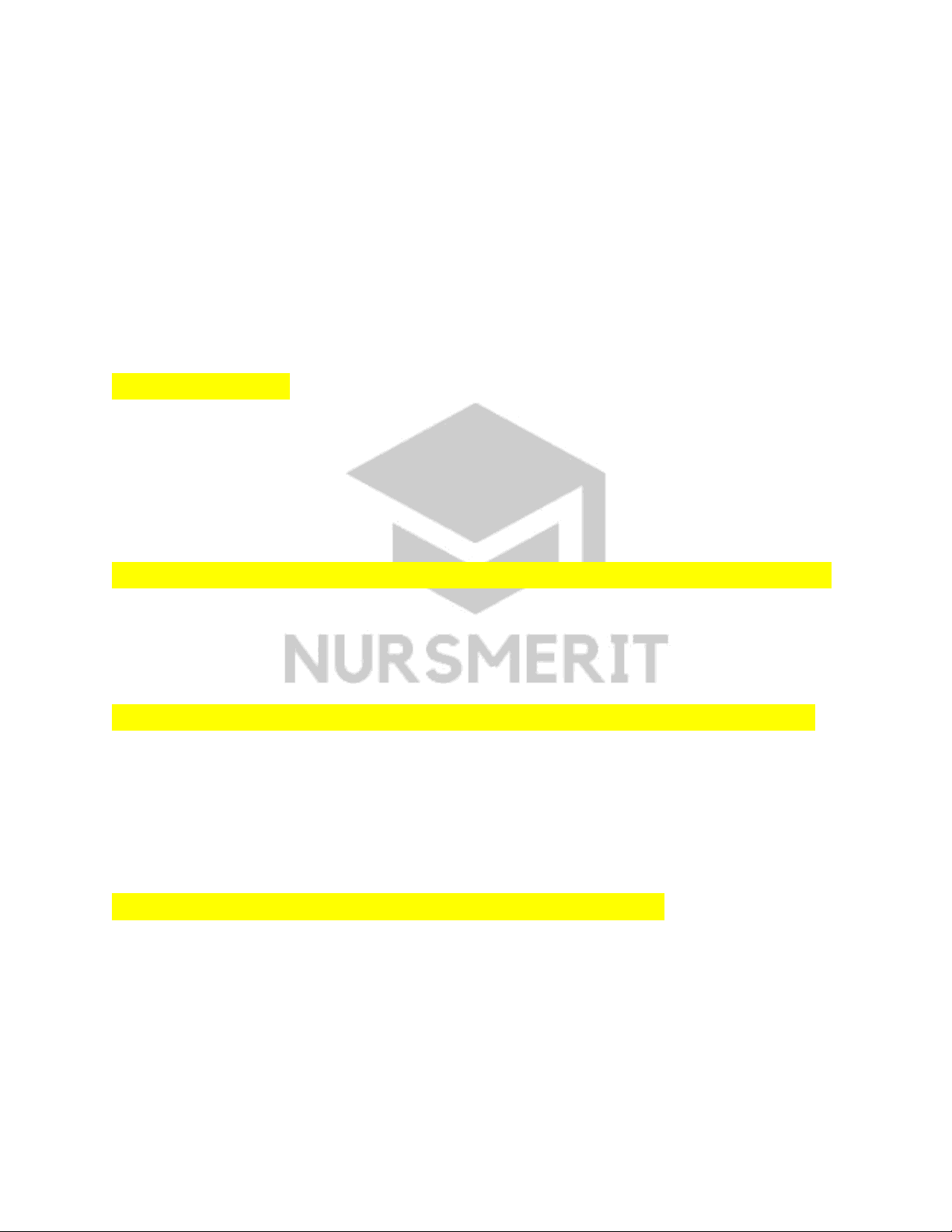
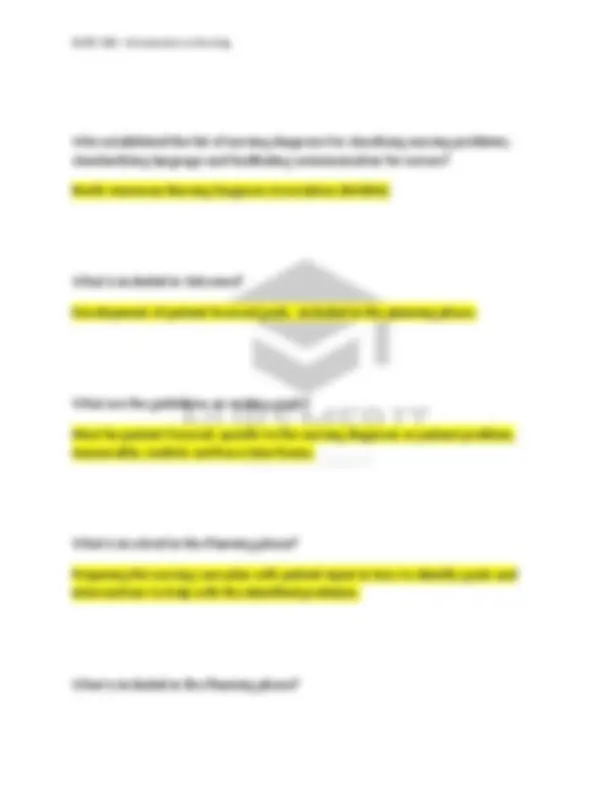
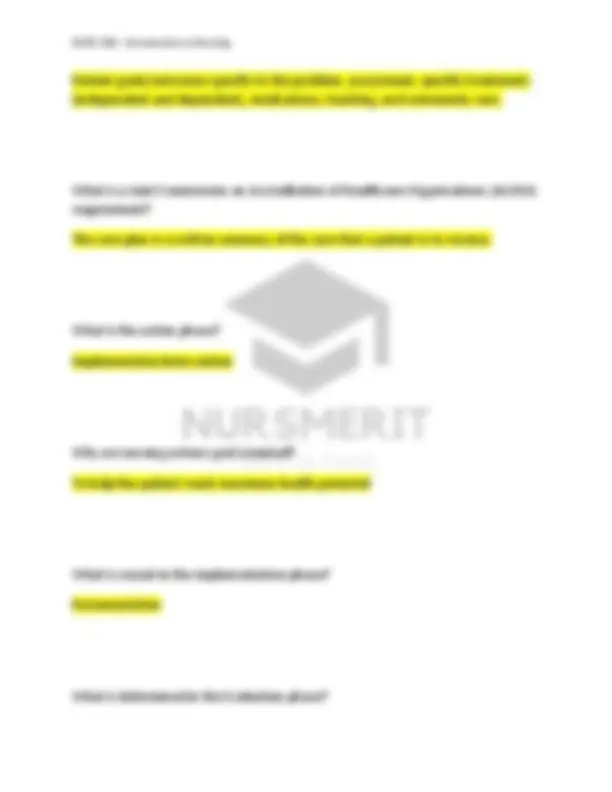
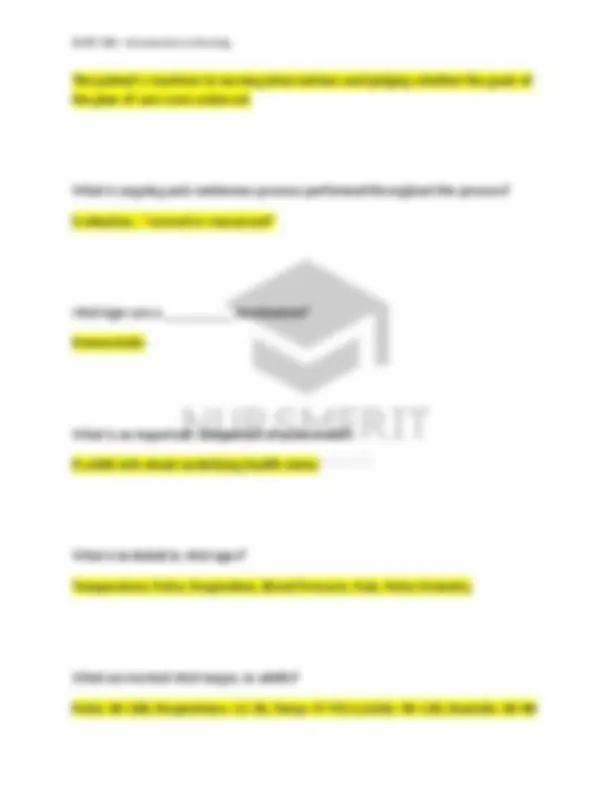
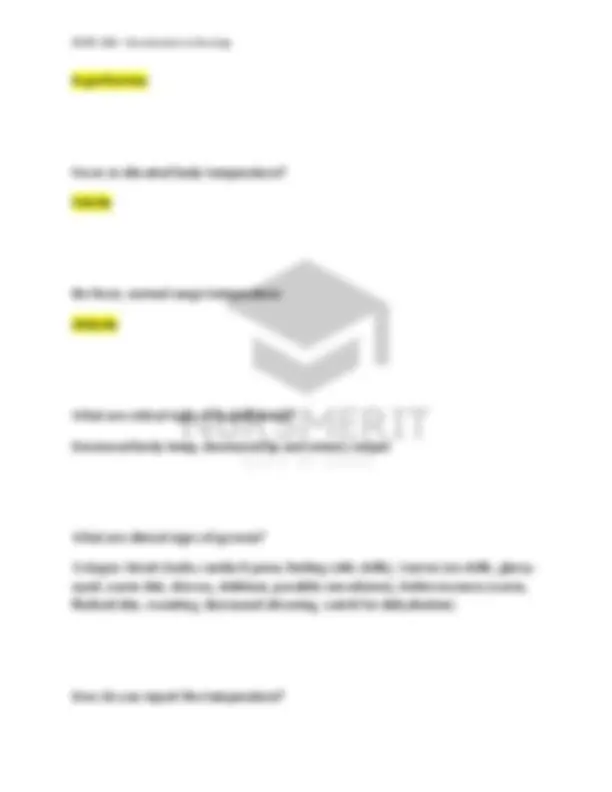
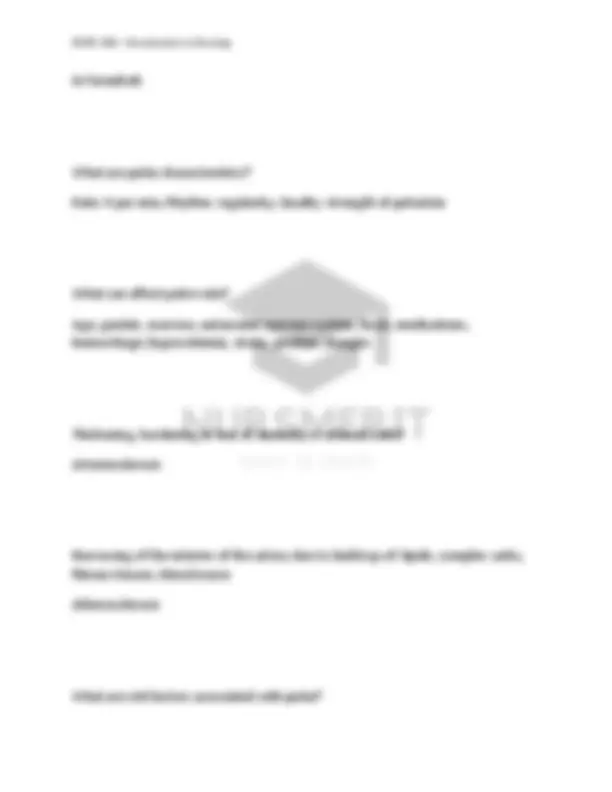
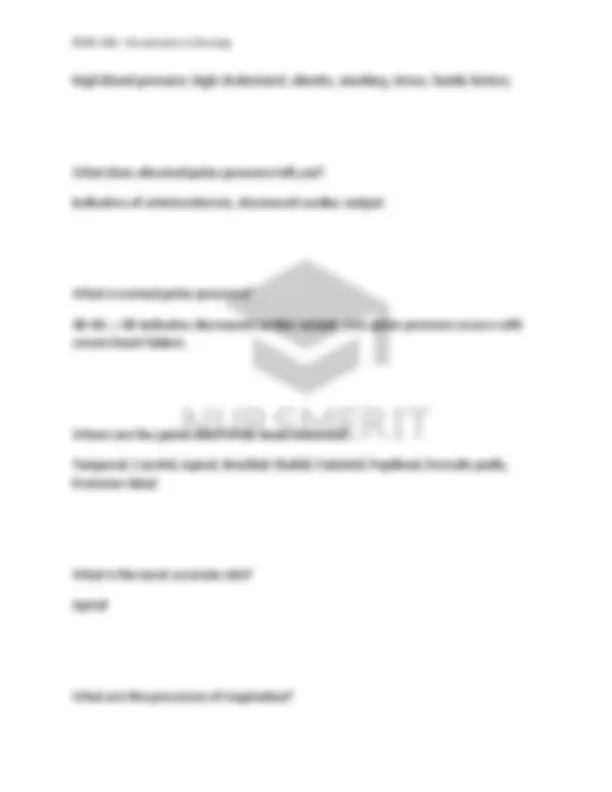
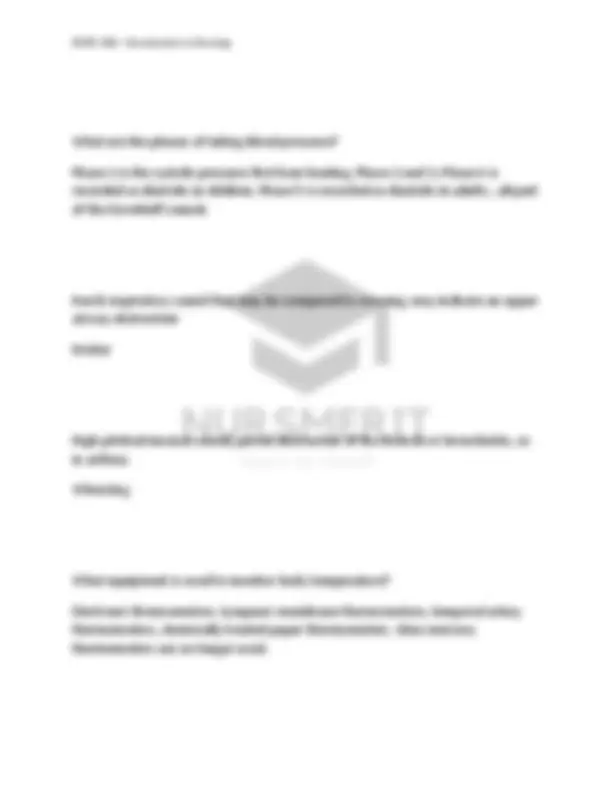
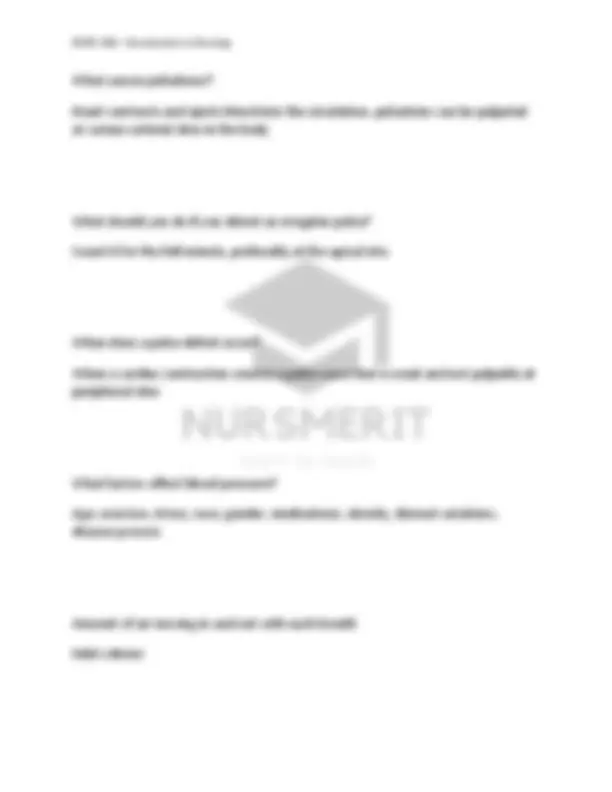
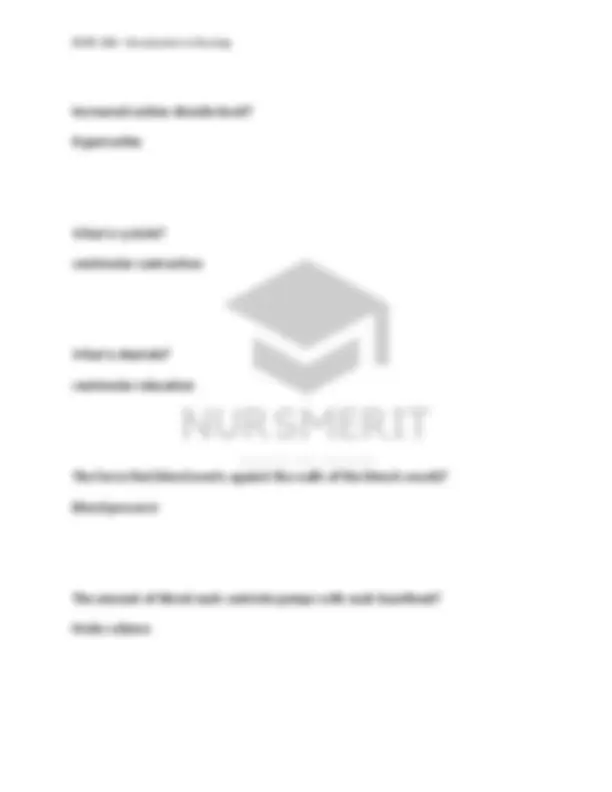
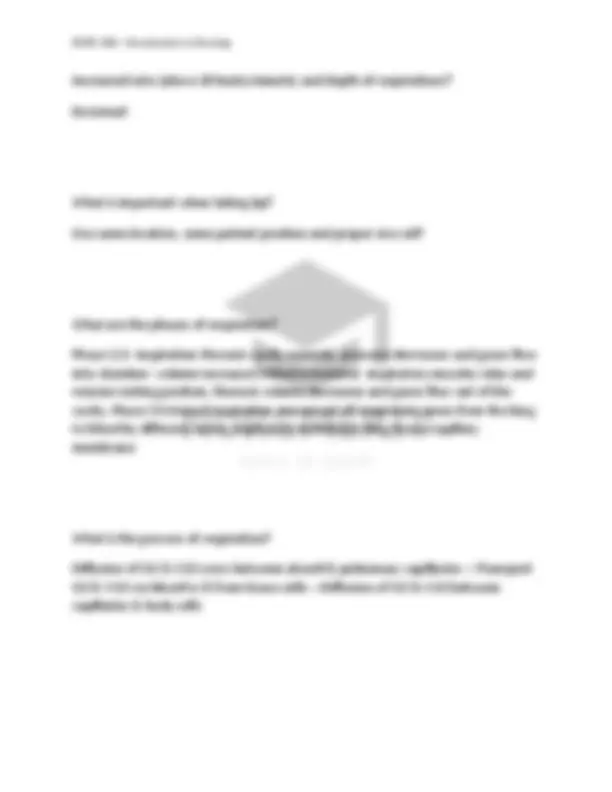

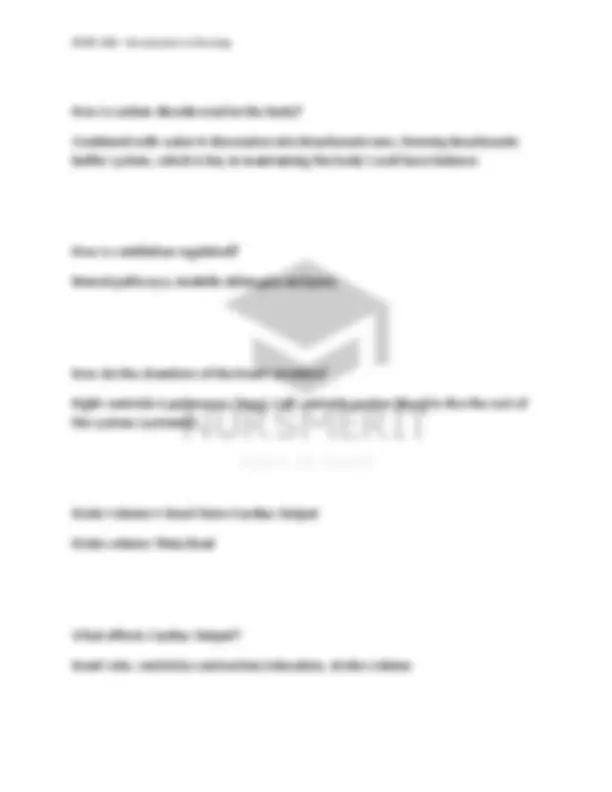
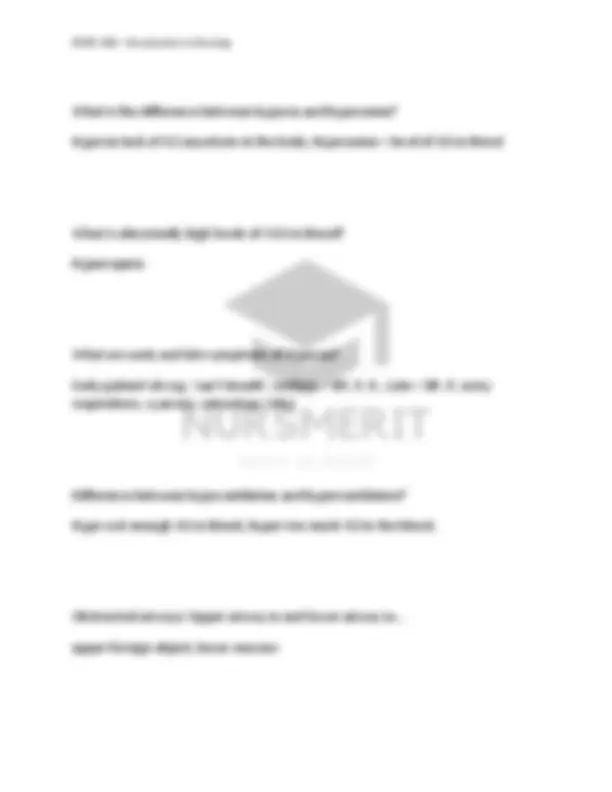
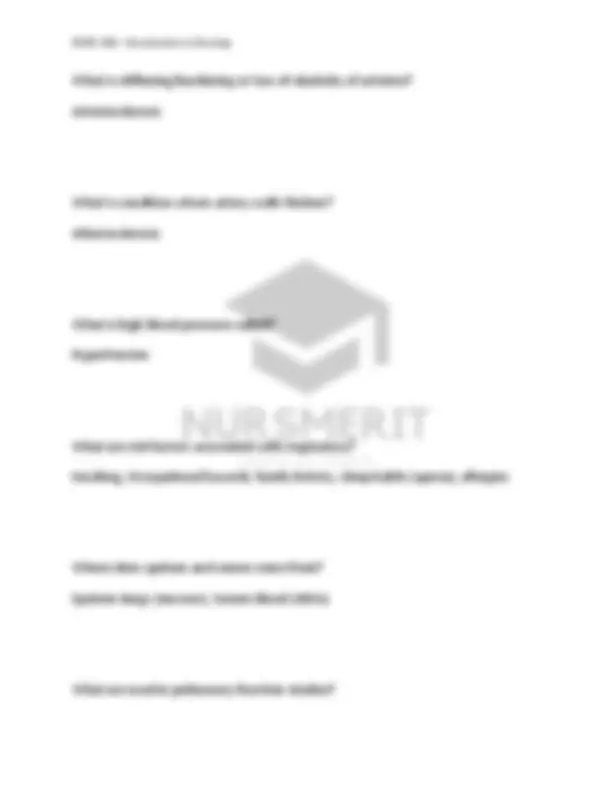
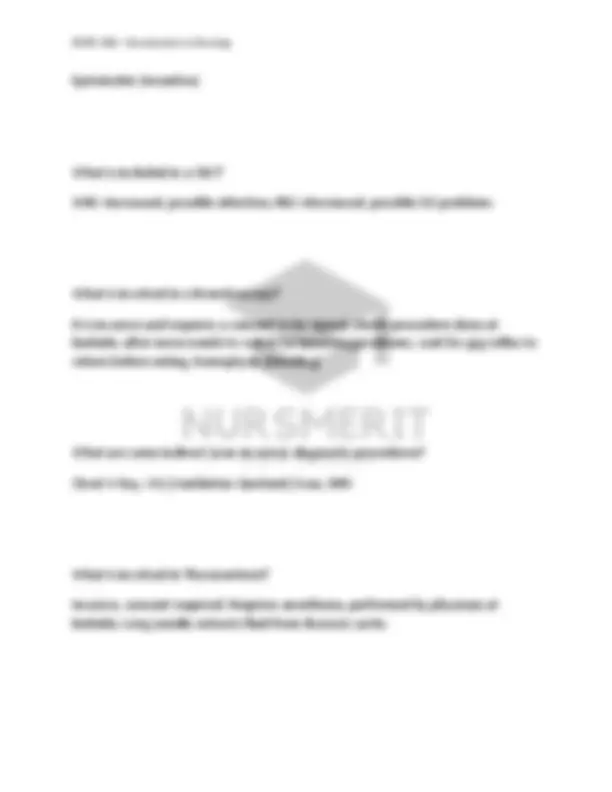
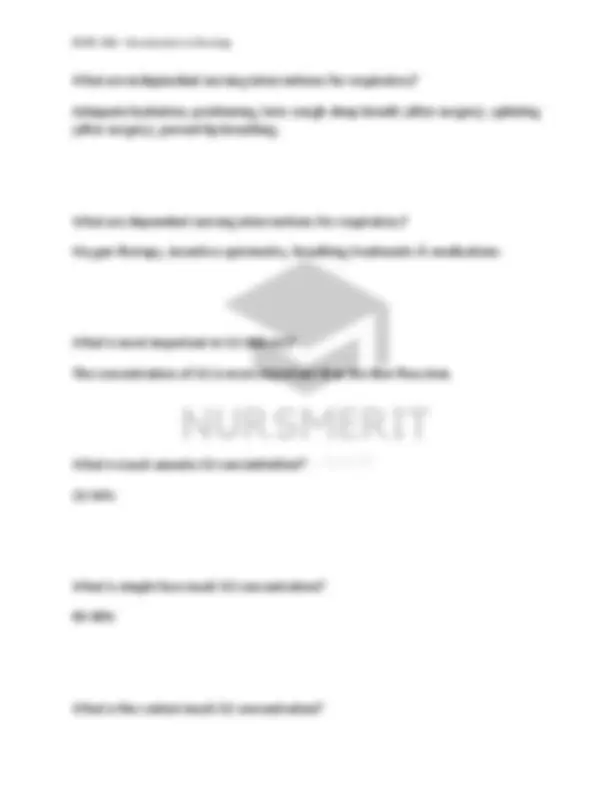
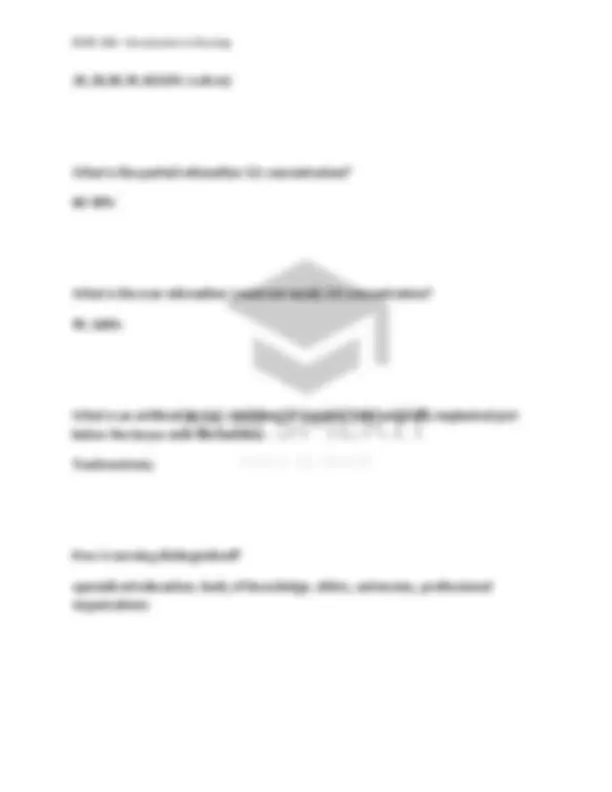
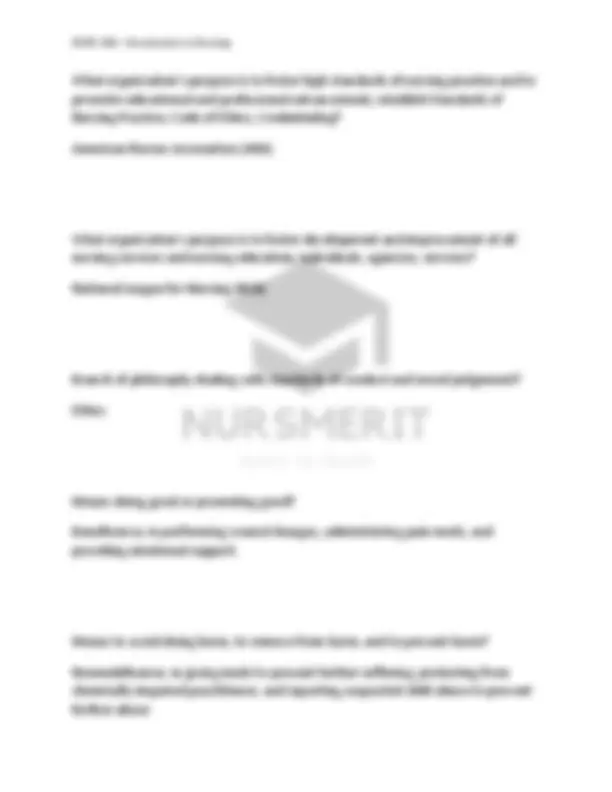
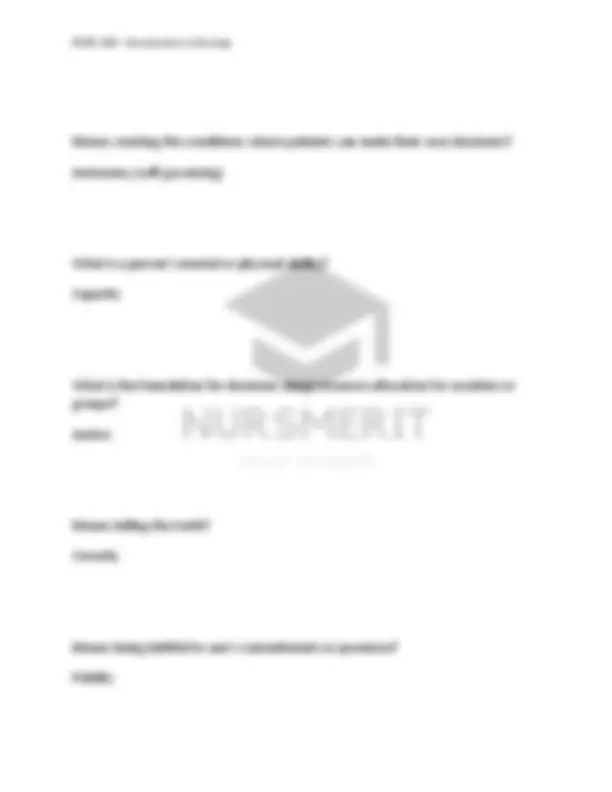
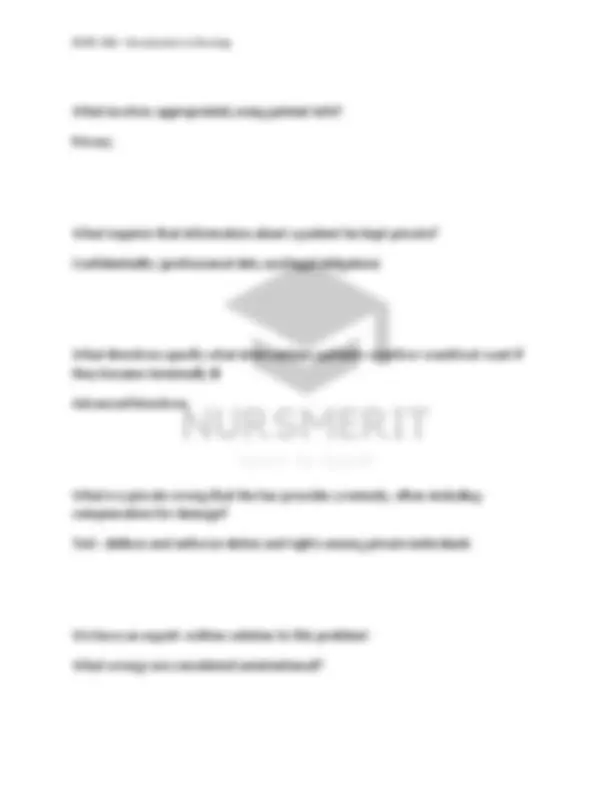
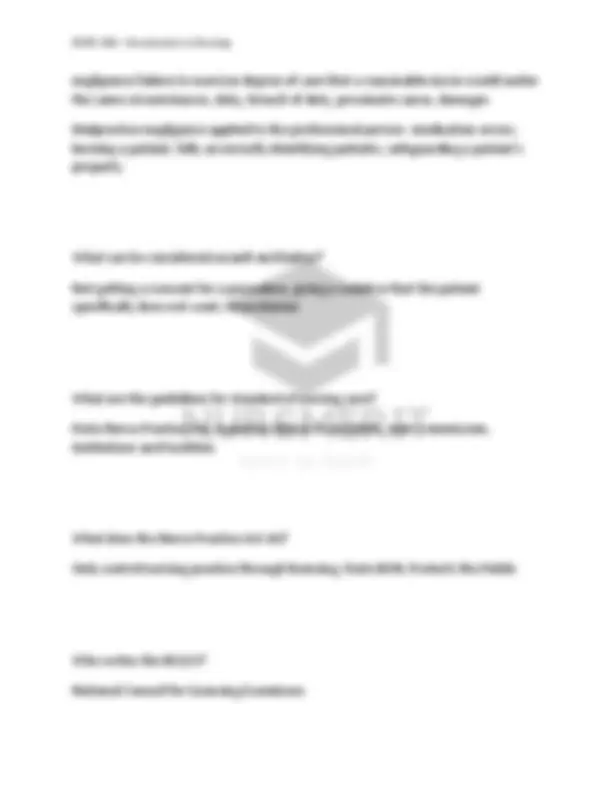
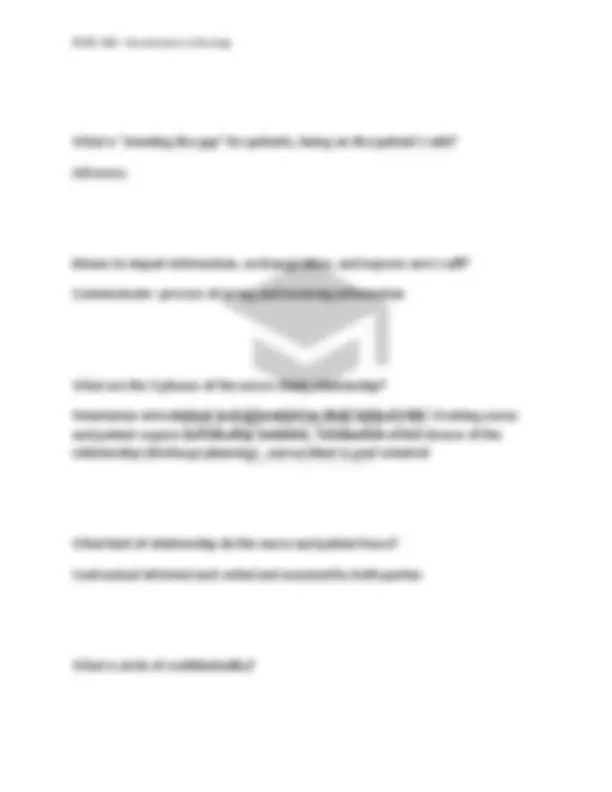
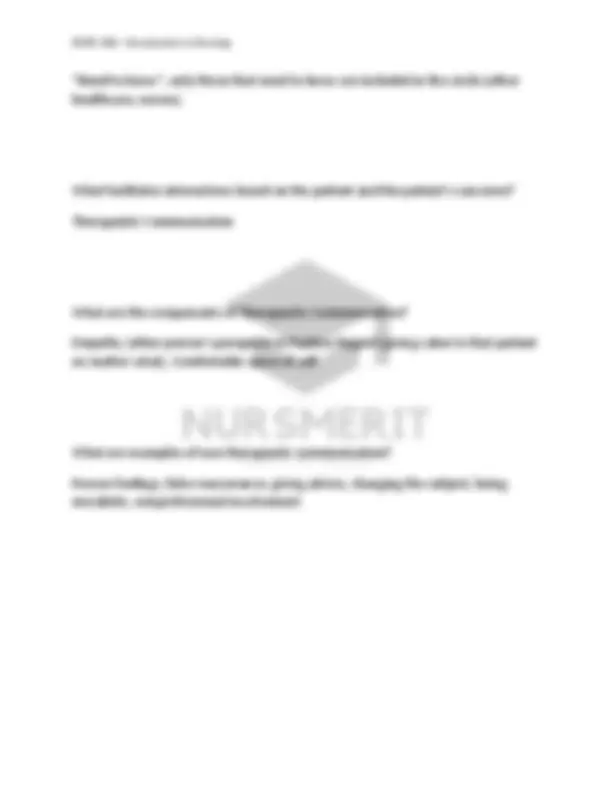


Study with the several resources on Docsity

Earn points by helping other students or get them with a premium plan


Prepare for your exams
Study with the several resources on Docsity

Earn points to download
Earn points by helping other students or get them with a premium plan
Community
Ask the community for help and clear up your study doubts
Discover the best universities in your country according to Docsity users
Free resources
Download our free guides on studying techniques, anxiety management strategies, and thesis advice from Docsity tutors
A comprehensive overview of key concepts and principles covered in nurs 100 - introduction to nursing, focusing on the nursing process, vital signs, and related terminology. It includes questions and answers that can be helpful for students preparing for their midterm exam. Topics such as assessment, diagnosis, planning, implementation, and evaluation, as well as the importance of vital signs in patient care.
Typology: Exams
1 / 31

This page cannot be seen from the preview
Don't miss anything!
























The foundation of the nursing profession; is the systematic approach to problem- solving and providing individualized care? The Nursing Process The phases of the nursing process? Assessment, Diagnosis, Planning (includes Outcome), Implementation, Evaluation What is Assessment? Collection of data to help establish a goal of making a clinical nursing judgment. Difference between subjective and objective data? Subjective, from the client; Objective, from the nurse's senses. Difference between primary, secondary and tertiary sources?
Primary, can only be the patient; Secondary, info from families, medical records, or other health care professionals; Tertiary, info from textbooks, nurse's and other health care team responses to patient What must be done by the nurse on admission to a health care facility? And what does it identify? In depth nursing history and physical assessment must be done and it identifies the patient's strengths and weakness/health problems. When does data collection take place? Through observations, interviews, physical assessment, and interpreting lab and diagnostic results. What is diagnosis? The clinical act of identifying problems using the assessment data collected. This step identifies an individual, family or group response to an actual or potential health problem. What is the nursing diagnosis based on? The pathophysiology of the disease process.
Patient goals/outcomes specific to the problem, assessment, specific treatments (independent and dependent), medications, teaching, and community care. What is a Joint Commission on Accreditation of Healthcare Organizations (JACHO) requirement? The care plan is a written summary of the care that a patient is to receive. What is the action phase? Implementatio/Intervention Why are nursing actions goal oriented? To help the patient reach maximum health potential What is crucial in the implementation phase? Documentation What is determined in the Evaluation phase?
The patient's reactions to nursing interventions and judging whether the goals of the plan of care were achieved. What is ongoing and continuous process performed throughout the process? Evaluation..."revised or reassessed" Vital signs are a __________ mechanism? Homeostatic What is an important component of assessment? It yields info about underlying health status What is included in vital signs? Temperature, Pulse, Respiration, Blood Pressure, Pain, Pulse Oximetry What are normal vital ranges, in adults? Pulse: 60- 1 00; Respirations: 12-20; Temp: 97-99; Systolic: 90-120; Diastolic: 60- 80
Temp of skin, subcutaneous tissue, and fat What factors affect temperature? Age, environment, time of day, exercise, stress and hormones. (temp is lowest in am) What are the temperature sites? What is most inaccurate and most dangerous? Mouth (frenulum), axilla, rectum, ear, forehead. Most inaccurate is the axilla, most dangerous is rectum. Elevated body temperature? Hyperthermia Fever? (exceeds 99.6F) Pyrexia Decreased body temperature?
Hypothermia Fever or elevated body temperature? Febrile No fever, normal range temperature Afebrile What are critical signs of hypothermia? Decreased body temp, decreased bp and urinary output What are clinical signs of pyrexia? 3 stages: Onset (tachy-cardia & pnea, feeling cold, chills), Course (no chills, glassy- eyed, warm skin, drowsy, delirium, possible convulsions), Defervescence (warm, flushed skin, sweating, decreased shivering, watch for dehydration) How do you report the temperature?
High blood pressure, high cholesterol, obesity, smoking, stress, family history What does elevated pulse pressure tell you? indicative of arteriosclerosis, decreased cardiac output. What is normal pulse pressure? 30 - 40...<30 indicates decreased cardiac output. Low pulse pressure occurs with severe heart failure. Where are the pulse sites? From most common? Temporal, Carotid, Apical, Brachial, Radial, Femoral, Popliteal, Dorsalis pedis, Posterior tibial What is the most accurate site? Apical What are the processes of respiration?
External-oxygen in, carbon dioxide out; Internal-use of oxygen, production of carbon dioxide, and cellular gas exchange What factors affect respiration? Age, gender, medications, stress, exercise, altitude Normal respiratory rate and rhythm? Eupnea Normal adult rate for respirations? 12 - 20 breaths/min Slower, but regular respirations? Bradypnea (can occur after certain meds or injury to the brain) Increased respiratory rate; rapid, shallow breaths? Tachypnea (not neurologic)
What are the phases of taking blood pressure? Phase 1 is the systolic pressure-first hear beating, Phase 2 and 3, Phase 4 is recorded as diastolic in children, Phase 5 is recorded as diastolic in adults...all part of the Korotkoff sounds Harsh inspiratory sound that may be compared to crowing; may indicate an upper airway obstruction Stridor High-pitched musical sound; partial obstruction of the bronchi or bronchioles, as in asthma Wheezing What equipment is used to monitor body temperature? Electronic thermometers, tympanic membrane thermometers, temporal artery thermometers, chemically treated paper thermometers. Glass mercury thermometers are no longer used.
What causes pulsations? Heart contracts and ejects blood into the circulation, pulsations can be palpated at various arterial sites in the body What should you do if you detect an irregular pulse? Count it for the full minute, preferably at the apical site. When does a pulse deficit occur? When a cardiac contraction creates a pulse wave that is weak and not palpable at peripheral sites What factors affect blood pressure? Age, exercise, stress, race, gender, medications, obesity, diurnal variations, disease process Amount of air moving in and out with each breath tidal volume
What is equal to cardiac output? Blood flow What is the average cardiac output in a resting man? 5.5L per minute What increases as adults age? Blood pressure What influences heart rate, cardiac contractility, systemic vascular resistance, and blood volume? Autonomic nervous system What does systemic vascular resistance control? Blood volume and blood viscosity (thickness) Resistance in the pulmonary circulation? What does it affect?
Peripheral Vascular Resistance; opposition to blood flow or impedance can increase b/p, diastolic b/p is usually affected Blood pressure when a patient sits or stands? Orthostatic hypotension What are medications based on? Blood pressure What are cyclic breathing patterns characterized by shallow breathing alternating with periods of apnea? Biot's Cyclic breathing pattern characterized by periods of respirations of increased rate and depth alternating with periods of apnea? Cheyne-Stokes
What is a concentration of gases that is directly related to the concentration it has within the system? Partial pressure Amount of inhaled or exhaled from the lungs? Tidal volume Collapsed portion (alveoli) of the lung? Atelectasis A lipoprotein that reduces the surface tension, so that the alveoli in the lungs are able to expand? Surfactant How does blood transport the oxygen (2)? Small amounts are dissolved into plasma, but most is attached to hemoglobin (it carries it in molecular form--important for metabolism)
How is carbon dioxide used in the body? Combined with water it dissociates into bicarbonate ions, forming bicarbonate buffer system, which is key in maintaining the body's acid-base balance How is ventilation regulated? Neural pathways; medulla oblongata and pons How do the chambers of the heart circulate? Right ventricle is pulmonary (lung); Left ventricle pushes blood to the the rest of the system (systemic) Stoke Volume X Heart Rate=Cardiac Output Stoke volume 70mL/beat What effects Cardiac Output? Heart rate, ventricles contraction/relaxation, stroke volume